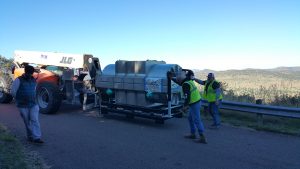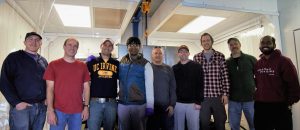The exciting news this week has been the arrival of the Habitable Planet Finder (HPF). This is the first of our new high resolution instruments and an instrument well suited to working in bright moon conditions. The HPF was designed and built by our Penn State partners and arrived on the 16th.
This instrument is designed for extremely high precision spectroscopy capable of detecting the reflex motion of stars as small earth sized planets go around them. To achieve that precision the instrument is housed in our temperature controlled basement at the HET inside a temperature controlled room inside a large temperature controlled vacuum chamber. All of these efforts allow them to control the temperature of the optics of the instrument at a level of 0.001 degrees Celsius.
After very carefully cleaning the enclosure that will house the vacuum chambered instrument the HPF team
was able to open their instrument and after a very through inspection proudly announced that they have just as many pieces of glass as they did in the assembly lab at Penn State (an optics joke). After a few final checks and the inclusion of their single moving part inside of the spectrograph they sealed up the vacuum chamber which, if things continue to go very well, may remain sealed for several years to come. The process of pumping the vacuum out of the large chamber took the rest of the weekend.
In the coming days and weeks the HPF team will monitor its stability, install the laser metrology system and get the systems ready for on-sky commissioning.
Quite an exhausting and exciting week at the HET!


